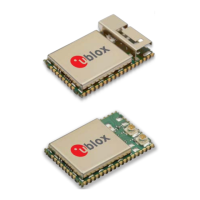ODIN-W2 series - System integration manual
UBX-14040040 - R20 Appendix Page 39 of 43
C1-Public
C XMODEM code example
Example showing a basic XMODEM implementation and a CRC calculation in C#.
private const int XMODEM_ACK = 6;
private const int XMODEM_NAK = 21;
private const int XMODEM_EOT = 4;
public Boolean XModemSend(Stream inputStream)
{
byte blockCnt = 0;
Boolean result = false;
BufferedStream bufferedInput = new BufferedStream(inputStream);
byte[] block = new Byte[133];
int bytesRead;
do {
for (int i = 0; i < 133; i++) {
block[i] = 0;
}
bytesRead = bufferedInput.Read(block, 3, 128);
blockCnt++;
block[0] = 1;
block[1] = blockCnt;
block[2] = (byte)(255 - blockCnt);
ushort crc = xmodemCalcrc(block, 3, 128);
block[131] = (Byte)((crc >> 8) & 0xFF);
block[132] = (Byte)(crc & 0xFF);
try {
this.Write(block, 0, block.Length);
} catch (Exception) {
result = false;
break;
}
try {
Byte res = (Byte)this.ReadByte();
while (res == 'C') {
res = (Byte)this.ReadByte();
}
if (res == XMODEM_ACK) {
DebugPrint(“Bytes sent {0}”, bytesRead));
if (bytesRead < 128) {
byte[] eot = new byte[1];
eot[0] = XMODEM_EOT;
this.Write(eot, 0, 1);
res = (Byte)this.ReadByte();
if (res == XMODEM_ACK) {
/* File sent ok */
result = true;
} else {
result = false;
}
}
} else {
// No ACK received, stop transmission no retransmission implemented
result = false;
break;
}
} catch (TimeoutException) {
result = false;
break;
}
}
while (bytesRead == 128);
DebugPrint(“Bytes sent {0}”, bytesRead));
bufferedInput.Close();
return result;

